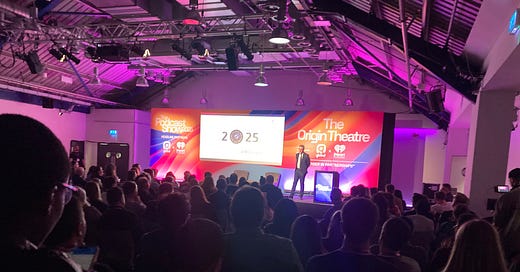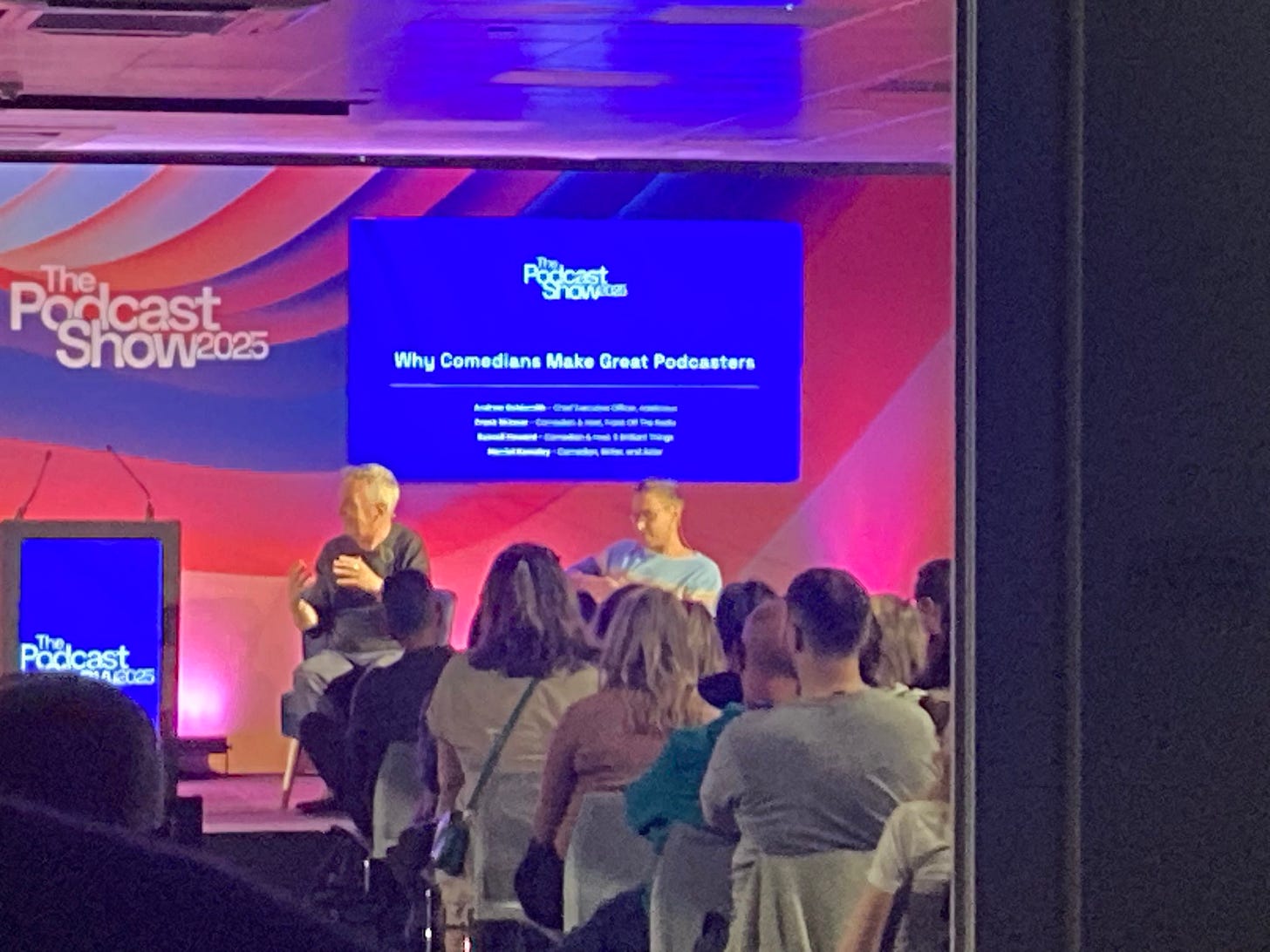The Podcast Show 2025: Podcast 3.0 will be ALL things
From multi-platform content machines to being loud and clear for Gen Z: Daniel J. McLaughlin's thoughts from The Podcast Show 2025
“Podcasts are something for your ears when the ears are busy.”
- James Cridland, editor of PodNews (‘Podcasting’s last year and the years to come’)
I didn’t expect the audibly gasp whilst attending one of the numerous panels during The Podcast Show 2025 in London. Attracting bemused looks from my colleagues in the audio-visual trade, my pantomime-esque response was to a comment from Max Cutler, the founder of PAVE Studios and self-titled “multi-hyphenate entrepreneur”, where he predicted that the term "podcasts" would become obsolete. It has become more than the sum of its parts. Instead, he offered the all-encompassing phrase: show.
When networking with my esteemed colleagues, I would often introduce myself as an “audio purist”; in previous meetings, I have somewhat pompously claimed that I am “the defender of all things audio”. This comment from Mr Cutler rattled me.
He proclaimed that Podcast 1.0 - the DIY operations and humble audio-first operations - is dead; Podcast 2.0 – videos and subscriptions with multi-platform creators – is very much the thing. Podcast 3.0 will be all things.
It is worth noting this warning from Dan Granger, chief executive officer of ad agency Oxford Road, who argues that the move to big budget video productions could “sap podcasting of any meaning whatsoever, eventually transforming “podcast” into a mushy word devoid of much significance – essentially a hollow synonym for “content” and a marketing term”.
However, audio purity is one way to be utterly left behind as podcasts continue to grow and evolve.
Podcast 3.0: multi-platform content machines
Podcast 2.0 is the multi-platform approach to video and audio, but the future of podcasting is even beyond the traditional platforms, such as Apple and Spotify. Steve Goldstein, founder and CEO of Amplifi Media, who attended the conference, notes:
“That phrase, creator economy, got plenty of airtime. But even as it was being used, you could sense pushback. Podcasting is not just about creators anymore. It’s about building multi-platform content machines: podcasts, yes, but also newsletters, videos, books, social influence, and even live events.”
It is interesting to see Mr Goldstein’s references to newsletters and live events, because these are both things that Goalhanger, the company behind ‘The Rest is Football’ and ‘The Rest is Politics’ successes alongside Gary Lineker, have explored. Goalhanger co-founder Jack Davenport said that the newsletter strategy is another way for communities to build around podcasts.

Interestingly, Mr Davenport also believes that live events do not always necessarily need their main hosts in attendance. With a celebrity-focused roster, including Mr Lineker, Alan Shearer, Micah Richards, Richard Osman, Marina Hyde, et al, it can be difficult to secure commitments to multiple dates at multiple venues. He argues that if the brand and format is strong enough, fans tolerate guest hosts at live shows.
Mr Cutler also recommended live events, though he described them more as a community-builder than an immediate money-maker:
“Live shows don’t make a lot of money, but they build a fandom experience. Every time a podcast goes on tour, the show ALWAYS grows.”
In regards to recruiting talent to front their podcasts, he said that the metric is either finding emerging talent on the way up or securing top-tier established talent; the middle tier of talent is avoided.
Video podcasts are non-negotiable, but don’t neglect audio!
Whilst there is still debate on what exactly constitutes a podcast, there is agreement that any successful podcasting strategy needs to include BOTH video and audio, working together; neither can be left behind. Or as the meme goes (such a millennial):
During the panel on ‘Building Global Media Brands in the Creator First Economy’ panel, Mr Davenport was clear that a video-first strategy is the only option for Goalhanger: “All of our podcasts have to be full video from day one – it’s non-negotiable.”
The emergence of video dominated many of the conversations during the conference. In 2024, Spotify rolled out video for its podcasts, and YouTube reportedly (well, self-reported) reached one billion views/listens/whatever they measured it by last year. It is predicted that Youtube will become the number one platform for all podcasts soon, overtaking Spotify and Apple Podcasts.
Lory Martinez, founder of Studio Ochenta, argues: “[It’s] not because people like video more: it's because YouTube is the best monetiser. Finding better monetisation options than ads and Patreon will be the key to success.”
According to Mr Cridland, only half of the top podcasts are using YouTube, however. He notes that dynamic ad insertion on YouTube is arriving in the future.
Not all podcasters are convinced by video. On the ‘Why Comedians Make Great Podcasters’ panel, Frank Skinner argued: “Video undermines the magic of audio. It’s like reading a great novel; it is about filling in the gaps.”
However, as Will Pearson, president of iHeartPodcast, explained in the ‘State of the Podcast Industry’ talk: it is not video OR audio; it’s both. Some work really well on video (celebrity-driven, talk show formats), whilst others clearly don’t (true crime, documentaries). He argues that you cannot force an audio podcast to suddenly become video (“if it works in video, it would be a TV or Netflix documentary”).
But those podcasts that are audio-first can expand into the video realm through derivative concepts: spin-off videos from the main audio show. The brand then becomes an umbrella of the central audio show, spin-off videos, and potentially elements such as newsletters, live events, etc.
Podcasts are a cost-effective content machine
A number of publishers were in attendance during The Podcast Show, including The Observer, the Financial Times, The Economist, et al.
The argument is that we cannot measure podcasts with the same metrics as our websites, and even videos. Podcasts have been defined as “democratised distribution” and “the opposite of scrolling”. It is often tempting to equate downloads/listens with page or video views, but the success of podcasting is through the time and attention it receives from listeners.
In the US, podcasts win on the time spent from digital audiences, beating TikTok, Facebook, Snapchat, Instagram, etc. They are deemed 23 times more trustworthy and authentic than other publishing mediums, with 80% of listeners trusting their hosts (on par with friends and family).

Publishers in the podcasting space are seen to have advantages in resources in two aspects: the resource of its newsroom, and the resource of its archive. Following the acquisition of The Observer, Tortoise Media is aiming to use the voices from its own newsroom, as James Harding, editor-in-chief explained in ‘The Renewed Observer’: The Future in Audio, Digital, and Print’ discussion:
“We are not in the two-hander, conversational game; we’re about stories. It is ‘washing line journalism’, but with a distinctive storyteller.”
He said that Tortoise is an “open newsroom” and it wants to invite the audience in, showing “our work” during investigations and podcast production. Mr Harding said that many are “disillusioned on how news treats its readers”, and podcasts can unlock what the Observer is in audio.
“Innovation, people think, is about design and format; the biggest thing in innovation is storytelling. Getting away from newspaper-ese.”
Podcasting is another way for audiences to engage with brands that they would not usually associate with. Radio DJ Scott Mills, appearing on a panel about the future of music formats, said that the BBC’s nostalgia content reached “opportunity audiences”.
He explained that the Pop Top 10 podcast, which he hosted alongside Rylan, reached people who do not usually listen to BBC Radio 2: “It was almost subterfuge to accidentally get casual listeners to our brands.”
Many of the listeners, he noted, had seen the clips from the podcast on social media, but did not engage with the full content. Podcasts cannot just be judged by the metrics on their central platform, but how they reach opportunity audiences across the board, including social media and YouTube.
Mr Mills added: “Podcasts are a cost-effective engine for content.”
Loud and clear to Gen Z audiences
There has been a 107% uplift in Gez Z audience engagement with podcasts since 2018, according to iHeartPodcast. Gez Z sees podcasts as challenging traditional media, covering topics that are left behind. The topics they are engaging with the most are:
♥️ Relationships (advice)
💼 Work/life balance
🧑⚕️ Health and wellness
💷 Entrepreneurs
👽 Weird internet culture
💬 Personal stories
💪 Body image
Publishers should not be afraid to appeal to new, diverse audiences, because they are fuelling audience growth. During the ‘Show Me the Money: Diverse Audiences and Revenue’ panel, it was predicted that engaging with black audiences in the podcasting space is a £300 billion opportunity.
Lydia Amoah, CEO of Blacklight, who has worked with News UK, the Telegraph, FT, and others, said that “representation is not cosmetic; it’s commercial”. She noted that 51% of 18 to 34-year-olds seek content that reflects them, whilst only 31% feel that the UK media represents them. 93% want brands to reflect inclusion.
Ms Amoah said: “When we’re counted, we’re empowered. When we’re understood, we drive growth. It is not charity; it is commercial intelligence.”






